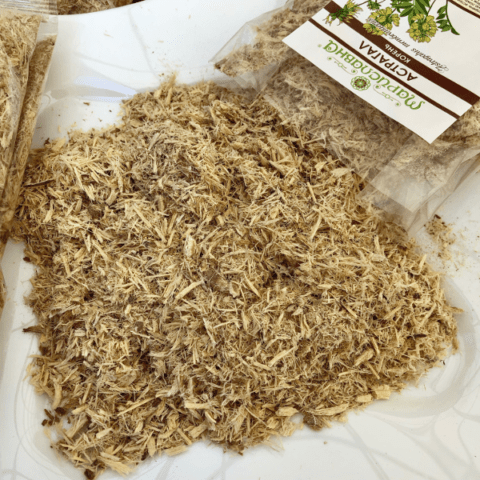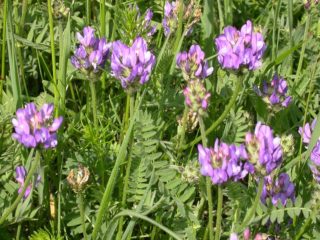Content
- 1 What it looks like and where it grows
- 2 Chemical composition
- 3 Medicinal properties of Astragalus membranaceus
- 4 Cooking methods
- 5 The use of the herb Astragalus membranaceus in folk medicine
- 6 Contraindications to the use of Astragalus membranaceus
- 7 Collection and preparation
- 8 Conclusion
- 9 Reviews of Astragalus membranaceus
The medicinal properties of Astragalus membranaceus and contraindications are associated with the rich chemical composition of this plant. It includes microelements, vitamins and biologically active substances. This allows the herb to be used for the treatment and prevention of viral and cancer diseases, as a sedative and laxative. Astragalus is also often recommended for the treatment of impotence.
What it looks like and where it grows
Astragalus (Astragalus) is a large genus of plants from the legume family (Fabaceae). One of the valuable representatives is Astragalus membranaceus, which is so named due to the presence of membranes in the fruit.
A perennial herbaceous plant of small height - from 30 to 70 cm.It looks like a compact, well-leafed, bright green bush with yellow flowers. The leaves are oblong, narrow, reaching 10–12 cm in length. Peduncles are single, multi-flowered, rising up to 70 cm. The inflorescences are yellow, appearing in the first half of summer. The fruits are formed closer to mid-August. Stems are erect, bare. The roots are thick and well developed.

Astragalus membranaceus blooms in summer: June and July
The plant is distributed everywhere. It is found in the temperate climate zone and in the tropics of the Northern Hemisphere, as well as in the foothills of South America. Prefers mixed, birch, pine and larch forests. It is often found on the coasts of lakes, as it loves good moisture and light shading.
In Russia, it can be found in the south of Western and Eastern Siberia, as well as in the Amur region. In neighboring countries it is found in Mongolia, Kazakhstan, China and Korea.
Chemical composition
The benefits of membranous astragalus are determined by its chemical composition. Plant tissues contain substances characterized by high biological activity:
- polysaccharides;
- flavonoids;
- tannins;
- essential oils;
- organic acids;
- vitamins C and E;
- saponins;
- steroids;
- lignans;
- coumarins;
- triterpenoids;
- pterocarpans;
- trace elements (selenium, zinc, cobalt, sodium, copper, calcium, vanadium, phosphorus).
Medicinal properties of Astragalus membranaceus
Astragalus membranaceus has a beneficial effect on the body. It is used:
- As a general strengthening, tonic. Stimulates hemoglobin production.
- As an anti-cancer collection. Under the influence of the herb, cancer cells and their accumulations are destroyed in the early stages of development.
- Like a sedative.The decoction relaxes the nervous system and relieves increased excitability.
- To strengthen and dilate blood vessels. The infusion helps normalize blood pressure and heart rate.
- As an antioxidant. Thanks to the presence of selenium, taking astragalus prevents cancer and promotes rejuvenation.
- As an antiseptic. The skin surface is disinfected and purulent wounds are actively healed.
Therefore, preparations based on this herb are used as an adjuvant for the treatment of various pathologies and disorders:
- hypertension;
- vascular atherosclerosis;
- diabetes;
- cancer of the stomach, duodenum, liver, as well as lymphoma, neuroblastoma and leukemia;
- boils;
- boils.

Components of membranous astragalus help in the prevention and treatment of cancer
Beneficial properties of Astragalus membranaceus root for men
In folk medicine, membranous astragalus has long been used as a remedy for the treatment of sexual impotence (impotence). The healing properties are explained by the fact that it tones the body and normalizes blood pressure. Thanks to increased blood flow, sexual function is also restored. Astragalus is useful as a general tonic. This is especially important for men engaged in physical labor.
Cooking methods
Dried astragalus membranous root is sold in pharmacies (standard packaging of 25 g). You can prepare it for internal and external use in different ways - get a tincture, extract, decoction or powder. Standard course – 30 days with a break of 2 months. It is recommended to complete 4 cycles per year.
Tincture of Astragalus membranaceus
An alcohol tincture can be prepared using the raw material of membranous astragalus. The instructions are:
- For 1 tbsp. l. root will need 10 tbsp. l. medical alcohol (96%).
- Close the glass container with a lid and leave for 10 days in a dark place, shaking occasionally.
- The resulting mixture is filtered.
- Take 25 drops 3 times a day half an hour before meals, dissolved in 50 ml of water.
Astragalus membranaceus root extract
Pharmacies sell highly purified astragalus membranous root extract. It is obtained industrially and packaged in vegetable capsules. Use 1-3 pieces three times a day during meals.
At home, you can prepare an aqueous extract according to the following instructions:
- Take 1 tbsp. l. crushed raw materials.
- Pour in 400 ml of boiling water.
- Leave in a thermos overnight until completely cooled.
- Strain and take one glass per day (divided into 3 doses) half an hour before meals.
Decoction
The simplest option, which is recommended in many instructions, is a decoction of Astragalus membranaceus.
Cooking algorithm:
- Dry roots (1 tbsp) are poured into a container with boiling water (0.5 l), covered with a lid and left for an hour.
- Cool and filter.
- Take 3 times a day half an hour before lunch. Amount for one dose – 3 tbsp. l.
Powder
Astragalus membranaceus is also used in dried form (pictured). To do this, it does not need to be prepared (brewed in water or infused with alcohol). It is enough to take one teaspoon of raw material and mix it with the same amount of honey of any kind.

Dried astragalus membranous root is used 1 g three times a day half an hour before meals.
The use of the herb Astragalus membranaceus in folk medicine
Most often, the product is used internally in the form of tea. It is advisable to drink it before meals (20–30 minutes before). If you use membranous astragalus regularly (2-3 times a day), the strengthening effect can be felt after 3 weeks. The standard course duration is 1 month.
Treatment of hypertension
Astragalus membranaceus helps normalize high blood pressure. For treatment you need:
- Take 2 tbsp. l. crushed root or leaves and pour 200 ml of hot (no more than 80 degrees) water.
- Place in a water bath and heat over low heat for 15–20 minutes.
- Remove from heat, cool and strain.
- Take 2 tbsp. l. before meals 3 times a day. The course of treatment can be increased to 45 days, then pause for 2 months.
Treatment of atherosclerosis
Substances contained in the root of membranous astragalus help cleanse blood vessels of cholesterol. For this, an alcohol infusion is used. Keep it for at least two weeks. Take 30 drops 3 times a day before meals. The course lasts 10 days, then a break for 10 days and the cycle continues again.
General strengthening tea
Astragalus membranaceus is used as a tonic, strengthens the immune system and improves blood circulation. It is very easy to prepare:
- Take 2 tsp. herbs to 1 cup of boiling water.
- Leave for a few minutes with the lid closed.
Then drink it like regular tea, preferably 2-3 times a day. The entire course lasts one month. The herbal drink helps avoid respiratory infections.

Astragalus tea can be used as an additional means of strengthening the immune system.
Treatment of constipation
The herb is used as a natural laxative. Cooking algorithm:
- One tablespoon of roots is poured into a glass of boiling water.
- Leave for an hour, cool, filter.
A cleansing enema is given based on this solution. Usually the effect occurs within a day, the maximum duration of the course is 3 days. One procedure is carried out per day.
External use
To treat boils, abscesses and ulcers, prepare a strong infusion of astragalus:
- Use 2 tbsp. l. for 200 ml of boiling water.
- Leave for at least 6 hours in a warm place.
Soak gauze in the liquid and place a compress on the affected area for several hours (preferably overnight). The duration of treatment is unlimited. The herbal infusion can be used until complete recovery.
Contraindications to the use of Astragalus membranaceus
Astragalus membranaceus is a popular remedy that has few contraindications. This herb should not be used in the following cases:
- individual intolerance, allergic reactions;
- period of pregnancy and lactation (any stage);
- general serious condition against the background of serious illnesses;
- fever.
Collection and preparation
It is easy to distinguish Astragalus membranaceus from other species by its yellow flowers. The roots are collected in late autumn. To do this, they go to places remote from industrial enterprises, roads and other polluting sites.
You need to act carefully so as not to damage the roots. They are taken out of the ground and immediately shaken off and placed in a bag.Houses are washed to remove any remaining soil, laid out in a thin layer and dried in a well-ventilated area. Optimum temperature +25–28 °C. To speed up the process, the rhizomes of membranous astragalus can be placed in a dryer, setting the temperature to no higher than +30 °C.
Then the roots need to be chopped with a sharp knife so that they turn into a mixture that resembles straw. Packed in bags made of natural fabric and stored at room temperature and moderate humidity. Shelf life – no more than 12 months.

The above-ground part of the plant (stems, leaves) is harvested during the flowering of membranous astragalus, i.e. in June or July
Conclusion
The medicinal properties of Astragalus membranaceus and contraindications must be taken into account before using the herb. Infusions, decoctions and other forms are used as an additional means of treatment. If the dosage and other rules are followed, the positive effect is noticeable within a few weeks.
Reviews of Astragalus membranaceus









